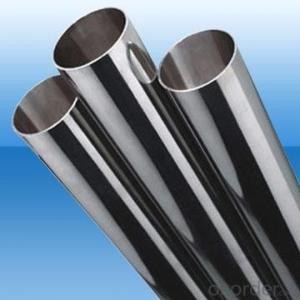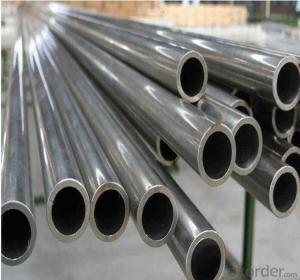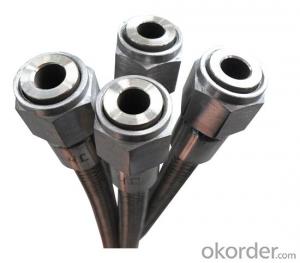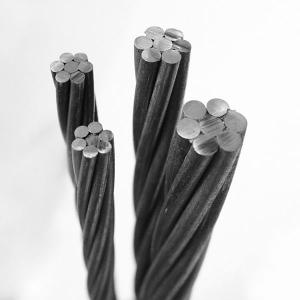Oil Gas Sewage Transport Usage Stainless Steel Pipe Made in China
- Loading Port:
- Tianjin
- Payment Terms:
- TT OR LC
- Min Order Qty:
- 35 m.t.
- Supply Capability:
- 5000 m.t./month
OKorder Service Pledge
OKorder Financial Service
You Might Also Like
Specification
Oil Gas Sewage Transport Usage Stainless Steel Pipe Made in China
1.Structure of Stainless Steel Pipe :
Seamless pipe is formed by drawing a solid billet over a piercing rod to create the hollow shell. As the manufacturing process does not include any welding, seamless pipes are perceived to be stronger and more reliable. Historically seamless pipe was regarded as withstanding pressure better than other types, and was often more easily available than welded pipe.
2.Main Features of the Stainless Steel Pipe :
• High manufacturing accuracy
• High strength
• Small inertia resistance
• Strong heat dissipation ability
• Good visual effect
• Reasonable price
3.Stainless Steel Pipe Specification:
Standard | GB, DIN, ASTM ASTM A106-2006, ASTM A53-2007 |
Grade | 10#-45#, 16Mn 10#, 20#, 45#, 16Mn |
Thickness | 8 - 33 mm |
Section Shape | Round |
Outer Diameter | 133 - 219 mm |
Place of Origin | Shandong, China (Mainland) |
Secondary Or Not | Non-secondary |
Application | Hydraulic Pipe |
Technique | Cold Drawn |
Certification | API |
Surface Treatment | factory state or painted black |
Special Pipe | API Pipe |
Alloy Or Not | Non-alloy |
Length | 5-12M |
Outer Diameter | 21.3-610mm |
Grade | 20#, 45#, Q345, API J55, API K55, API L80, API N80, API P110, A53B |
Standard | ASME, ASTM |
1) Material:20#(ASTM A 106/A53 GRB.API5LGRB,GB),45#,16Mn,10#.
2) Specification range:OD:21.3-610mm,WT:6-70mm,length:6-12m or according to the requirement of clients.
3) Excutive standards:GB,ASME API5L.ASTM A 106/A53,Despite of the above standards,we can also supply seamless steel pipe with standard of DIN,JIS,and so on,and also develop new products according to the requirements of our clients!
4) Surface:black lacquered,varnish coating or galvanized.
5) Ends:Beveled or square cut,plastic capped,painted.
6) Packing:bundles wrapped with strong steel strip,seaworthy packing.
4. Packing and Delivery:
Packaging Details: | seaworthy package,bundles wrapped with strong steel strip |
Delivery Detail: | 50-60days after received 30%TT or Original LC |
5. FAQ of Stainless Steel Pipe
A. How is the quality of your products?
Our products are manufactured strictly according to national and internaional standard, and we take a test on every pipe before delivered out. If you want see our quality certifications and all kinds of testing report, please just ask us for it.
Guaranteed: If products’ quality don’t accord to discription as we give or the promise before you place order, we promise 100% refund.
B. How about price?
Yes, we are factory and be able to give you lowest price below market one, and we have a policy that “ for saving time and absolutely honest business attitude, we quote as lowest as possible for any customer, and discount can be given according to quantity”,if you like bargain and factory price is not low enough as you think, just don’t waste your time.Please trust the quotation we would give you, it is professional one.
C. Why should you chose us?
Chose happens because of quality, then price, We can give you both.Additionally, we can also offer professional products inquiry, products knowledge train(for agents), smooth goods delivery, exellent customer solution proposals.Our service formula: good quality+good price+good service=customer’s trust
SGS test is available, customer inspection before shipping is welcome, third party inspection is no problem.
Any question, pls feel free to contact us !
6.Stainless Steel Pipe Images:

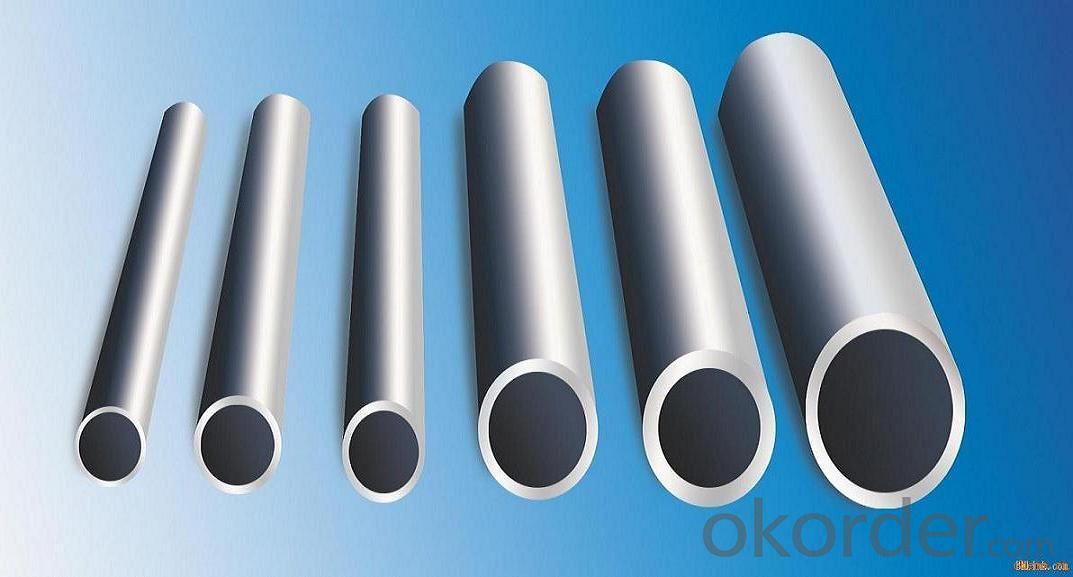
7. Company Information:
CNBM International Corporation (CNBM International) is the most important trading platform of CNBM Group Corporation, a state-owned company under the direct supervision of State-owned Assets Supervision and Administration Commission of the State Council.
In line with the business, CNBM International launched E-business platform Okorder.com.Our goal is to transform CNBM International into the global leading brand in building materials industry within 3 to 5 years through innovation and reform, by strengthening the overall management of supply chain, developing and cultivating both domestic and overseas market, improving the procedure and information system, enhancing the ability to organize resources and to provide value-added services under a professional team and a learning organization.
- Q:How do you join stainless steel pipes to other materials?
- Joining stainless steel pipes to other materials can be achieved through several methods, depending on the specific application and requirements. Here are a few common techniques used: 1. Welding: Welding is the most common and effective method for joining stainless steel pipes to other materials. Different types of welding processes such as TIG (Tungsten Inert Gas) welding, MIG (Metal Inert Gas) welding, or stick welding can be used, depending on the material being joined and the desired strength of the joint. Welding provides a strong and durable bond between stainless steel pipes and other materials. 2. Flanges: Flanges are commonly used to join stainless steel pipes to other materials in applications that require easy disassembly or connection to different equipment. Flanges are typically made from materials such as carbon steel, cast iron, or even stainless steel itself. The flanges are bolted together, creating a secure joint that can be easily disconnected when needed. 3. Threaded connections: Stainless steel pipes can also be joined to other materials using threaded connections. This method is often used for smaller diameter pipes or when the pipes need to be easily removed or replaced. The threaded connections can be made using pipe fittings such as couplings, unions, or adapters, which have male and female threads that screw together to form a tight seal. 4. Compression fittings: Compression fittings are another option for joining stainless steel pipes to other materials. These fittings consist of a compression nut, a ferrule, and a body that houses the ferrule. The ferrule is compressed onto the pipe, creating a tight seal when the compression nut is tightened. Compression fittings provide a reliable and leak-free joint between stainless steel pipes and other materials. 5. Mechanical connectors: In some cases, mechanical connectors can be used to join stainless steel pipes to other materials. These connectors typically involve clamping or fastening mechanisms that secure the pipes together without the need for welding or threading. Mechanical connectors can be a suitable option in situations where disassembly and reassembly are required. It is important to consider the specific application, material compatibility, and the required strength and durability of the joint when selecting the appropriate method to join stainless steel pipes to other materials. Consulting with a professional or referring to industry standards and guidelines is recommended to ensure a proper and reliable connection.
- Q:Are stainless steel pipes resistant to pitting and crevice corrosion?
- Stainless steel pipes exhibit high resistance to pitting and crevice corrosion as a result of the chromium oxide protective layer on their surface. This layer acts as a barrier, effectively warding off corrosive elements. Furthermore, it possesses the remarkable ability to self-heal, swiftly regenerating in the event of any damage, thus ensuring continued resistance against corrosion. Given these qualities, stainless steel pipes find widespread usage in various industries, such as chemical, oil and gas, and food processing, where they are constantly exposed to aggressive surroundings. All in all, stainless steel pipes are a dependable option when corrosion resistance is of utmost importance.
- Q:Can stainless steel pipes be used for petrochemical plants?
- Yes, stainless steel pipes can be used for petrochemical plants. Stainless steel is known for its excellent corrosion resistance, high temperature resistance, and durability, making it suitable for handling various chemicals and fluids in petrochemical plants. Additionally, stainless steel pipes can withstand high-pressure environments, making them ideal for petrochemical industry applications.
- Q:Can stainless steel pipes be buried in soil?
- Yes, stainless steel pipes can be buried in soil. Stainless steel is highly resistant to corrosion and can withstand the harsh conditions of being buried underground, making it a suitable choice for various underground applications such as drainage, sewage, and water supply systems.
- Q:What are the temperature limits for stainless steel pipes?
- The temperature limits for stainless steel pipes can vary depending on the grade of stainless steel used. Generally, stainless steel pipes can withstand temperatures ranging from -150°C to 1100°C (-238°F to 2012°F). However, it is crucial to consider factors such as the specific stainless steel grade, the application, and any potential thermal expansion or contraction issues when determining the temperature limits for a particular stainless steel pipe.
- Q:Can stainless steel pipes be welded?
- Yes, stainless steel pipes can be welded. Stainless steel is a popular material used in various industries due to its high corrosion resistance and strength. Welding is one of the common methods used to join stainless steel pipes together. However, it is important to use the appropriate welding techniques and equipment to ensure a successful weld. Stainless steel has different grades, each with its own specific welding requirements. The welding process for stainless steel pipes typically involves using a filler material that matches the grade of stainless steel being welded. It is also crucial to properly clean and prepare the surfaces to be welded to ensure a strong and durable joint.
- Q:Stainless steel pipe pickling ratio
- Usage: apply proper amount of this product onto the surface of stainless steel to be processed, the thickness of 1~2 mm, 5-30 minutes or longer (by dirt, sheet materials and processing requirements), process the best brush a few times, the surface oxide skin, rust completely clean, with water (lime water or salt water better) rinse, avoid rust.
- Q:What is the maximum operating pressure for stainless steel pipes?
- The maximum operating pressure of stainless steel pipes is determined by several factors, including the grade of stainless steel, pipe diameter, and fluid temperature. In general, stainless steel pipes have higher pressure handling capabilities compared to other materials due to their inherent strength and resistance to corrosion. For instance, stainless steel pipes made from grade 304 or 316, which are commonly used across various industries, can withstand maximum operating pressures ranging from 1000 to 3000 psi or even higher, depending on the specific application and pipe size. However, it is essential to refer to the manufacturer's specifications and guidelines to ascertain the exact maximum operating pressure for a particular stainless steel pipe. It is important to consider that the maximum operating pressure can also be influenced by factors such as pipe wall thickness, pipe fittings, and joint connections. Hence, proper design, installation, and maintenance are crucial to ensure the safe and efficient operation of stainless steel pipes at their maximum operating pressure. Seeking guidance from a professional engineer or a specialist in stainless steel piping systems can provide accurate and specific information for a given application.
- Q:Can stainless steel pipes be used for firefighting systems?
- Firefighting systems can utilize stainless steel pipes due to their durability and resistance to corrosion. The material's ability to withstand heat, pressure, and chemicals makes it suitable for transporting water, foam, and other fire suppression agents. In addition to its high strength and ability to endure extreme conditions, stainless steel pipes are also recognized for their smooth inner surface, which reduces friction loss and maximizes water flow. This quality is crucial for the effectiveness of firefighting operations. Overall, stainless steel pipes offer a dependable and long-lasting solution for firefighting systems, ensuring safety and efficiency in critical situations.
- Q:Can stainless steel pipes be used for desalination systems?
- Yes, stainless steel pipes can be used for desalination systems. Stainless steel is a corrosion-resistant material that can withstand the harsh conditions of desalination processes, which involve the removal of salt and other impurities from seawater. The high corrosion resistance of stainless steel makes it an ideal choice for conveying the treated water, as it helps to maintain the purity of the water and prevent contamination. Additionally, stainless steel pipes offer excellent mechanical properties, such as strength and durability, that are crucial for the efficient functioning of desalination systems.
1. Manufacturer Overview |
|
|---|---|
| Location | |
| Year Established | |
| Annual Output Value | |
| Main Markets | |
| Company Certifications | |
2. Manufacturer Certificates |
|
|---|---|
| a) Certification Name | |
| Range | |
| Reference | |
| Validity Period | |
3. Manufacturer Capability |
|
|---|---|
| a)Trade Capacity | |
| Nearest Port | |
| Export Percentage | |
| No.of Employees in Trade Department | |
| Language Spoken: | |
| b)Factory Information | |
| Factory Size: | |
| No. of Production Lines | |
| Contract Manufacturing | |
| Product Price Range | |
Send your message to us
Oil Gas Sewage Transport Usage Stainless Steel Pipe Made in China
- Loading Port:
- Tianjin
- Payment Terms:
- TT OR LC
- Min Order Qty:
- 35 m.t.
- Supply Capability:
- 5000 m.t./month
OKorder Service Pledge
OKorder Financial Service
Similar products
New products
Hot products
Hot Searches
Related keywords
